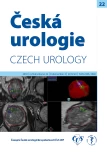Robotic‑assisted resection of a large angiomyolipoma of the left kidney
Authors:
Petr Hušek; Josef Košina; Jaroslav Pacovský
Authors‘ workplace:
Urologická klinika FN v Hradci Králové
Published in:
Ces Urol 2018; 22(4): 234-237
Category:
Video
Overview
Introduction:
A robotic system is another major step in the development of minimally invasive surgery in the pelvic as well as upper urinary tract regions. In terms of resection procedures of the kidney, it stretches the possibilities of mini‑invasiveness to even where laparoscopy, due to tumour size or position, is no longer feasible or is too risky. What we consider the greatest benefit of a robotic system is the possibility of a safe treatment of the resection bed. This fact gives the courage to relatively safely attempt to perform a minimally invasive procedure in a setting where classic open approach was indicated previously.
Method:
A 55-year‑old male patient with a finding of a large angiomyolipoma of the left kidney was referred to our centre for consultation. The size of the tumour was 68 x 55 x 78 mm with a centrally extending portion.The patient had been followed up at his catchment area facility for two years. Due to an increasing size of the tumour over time and an increased risk of rupture and major bleeding, a decision was made to use an active approach. The EAU guidelines on the treatment of AML are rather unequivocal. The criterion of 4 cm AML that has been used for years as an indication criterion for surgical management is no longer present in the 2018 guidelines. The patient had successive consultations at several practices with a proposal to remove the whole affected kidney. One of the options considered was multi‑stage vasographic obliteration of the tumour, however, with an uncertain outcome. At our centre, the patient was offered robotic‑assisted resection, bearing in mind a high risk of nephrectomy. The procedure was performed in the right flank position with the da ‑ Vinci® Xi robotic surgical system using three robotic arms (a camera, bipolar instrument, and monopolar scissors or needle driver) and one assistant port. Normally, we do not use the fourth robotic arm (prograsp) during resection procedures. The reason for this is only minimal benefit from its use for the surgeon as well as an effort to reduce the costs. If necessary, its role can be taken over by the assistant port. After releasing adhesions in the abdominal cavity, incision of the posterior peritoneum, and colon mobilization, the tumour and the adjacent portion of the kidney were exposed. The hilum was dissected and, during the course of resection and the placement of the first layer of suturing, the renal artery was clamped. To place stitches around the resection area, including the open hollow system, V‑LocTM sutures were used in three successive steps, while being anchored with non‑absorbable Hem‑o - lok® clips. Given the price and excellent experience, we exclusively use non‑absorbable clips at our centre. The suturing of the resection area was thus performed in two layers, with the third suture used to close the Gerota fascia. We have very good experience with this absorbable, self‑tightening suture from laparoscopic procedures. It enables rapid and safe treatment of the resection area without a need for knotting. The specimen was extracted from the body using an endobag through an extended port site at the umbilicus. A drain was passed through the lateral port. The surgery was uneventful. Following surgery, a 48-hour resting period was ordered, with the drain having been removed after 24 hours. The postoperative course was completely uneventful. As of now, the patient is one year since surgery, with no evidence of local recurrence on ultrasound. Follow‑up appointments are scheduled at yearly intervals; prospectively, he will be discharged from surveillance.
Results:
The duration of surgery was 126 mins (skin to skin), out of which the procedure itself took 80 mins, docking 10 mins, and undocking, specimen extraction and wound suturing 26 mins. Blood loss was 50 ml. The renal artery was clamped for 12 mins. Angiomyolipoma was confirmed by histology. The duration of hospital stay was 5 days.
Conclusion:
Robotic‑assisted resection of renal tumours is another advancement in minimally invasive upper urinary tract surgery. There has been a major increase in the numbers of patients who can be offered minimally invasive surgery regarding the size of the tumour, its position, or safe treatment of the resection bed.
KEY WORDS
Angiomyolipoma, robotic resection, mini-invasiveness.
Labels
Paediatric urologist Nephrology UrologyArticle was published in
Czech Urology

2018 Issue 4
Most read in this issue
- Andrological factor-the influence of age on the success of assisted reproduction?
- Correlation of invasive methods and urine cytology in detection of urothelial neoplasms: one centre early experience with application of The Paris System for Reporting Urinary Cytology
- Current status of urine cytology: what should the urologist know?
- New options of intravesical instillation therapy in bladder cancer
